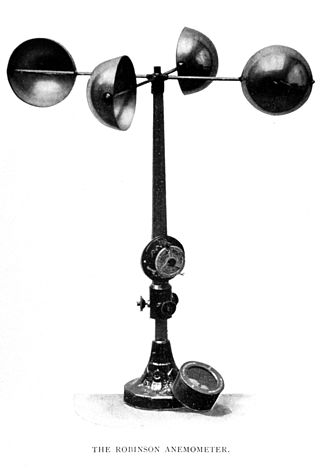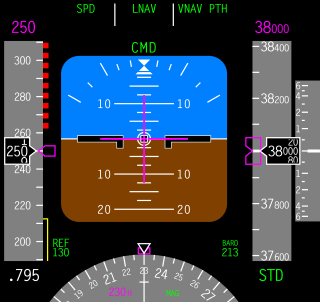
Pitometer logs (also known as pit logs) are devices used to measure a ship's speed relative to the water. They are used on both surface ships and submarines. Data from the pitometer log is usually fed directly into the ship's navigation system.

Pitometer logs (also known as pit logs) are devices used to measure a ship's speed relative to the water. They are used on both surface ships and submarines. Data from the pitometer log is usually fed directly into the ship's navigation system.
All nautical instruments designed to measure the speed of a ship through water are known as logs. [1] This nomenclature dates back to days of sail when sailors tossed a log attached to rope knotted at regular intervals off the stern of a ship. The sailors would count the number of knots that passed through their hands in a given period of time. Today sailors still use the unit of knots to express a ship's speed. The speed of the ship was needed to navigate the ship using dead reckoning, which was standard practice in the days before modern navigation instruments like GPS.
During World War II, pitometer logs were often interfaced directly into warship fire control systems. This interface was necessary to allow gunnery and torpedo fire control systems to automatically track targets.
The pitometer log was patented [2] in 1899 by Edward Smith Cole.

The basic technology of the pitometer log is similar to that of the pitot tube on an aircraft. Typically, the pitometer has a long tube that penetrates the ship's hull near the keel. The part of the pitometer protruding from the ship is sometimes called a pit sword or rodmeter. This tube usually has two openings: one facing the direction of seawater motion that is used to measure the dynamic pressure of the seawater and one at 90° to the direction of seawater motion that is used to measure the static seawater pressure. The dynamic pressure of the seawater is a function of the depth of the water and the speed of the vessel.
In early realizations of the pitometer log, mercury manometers [3] were used to measure the pressure differences (see Figure 1). [2] Later realizations used approaches that would generate equalizing pressures within the pitometer that would balance out the dynamic pressure. This eliminated the need for mercury manometers. [4]
An expression can be derived for the velocity of water impacting the ship as a function of the difference in dynamic and static water pressure using Bernoulli's principle. The total pressure of the water in the tube with moving seawater can be described by Equation 1.
| (Equation 1) |
|---|
Since water is an incompressible fluid, the dynamic pressure component of the total pressure can be expressed in terms of the water density and the water velocity as is shown in Equation 2.
| (Equation 2) |
|---|
Equation 2 can be solved for the velocity of water in terms of the difference in pressure between the two legs of the manometer. Equation 3 shows that velocity is a function of the square root of the pressure difference.
| (Equation 3) |
|---|
Because the speed computed by the pitometer is a function of the difference between pressure readings, the pitometer does not produce an accurate result when the ship's velocity is low and the two pressure readings are nearly the same.
While the pitometer log is very commonly used today, there are a number of other logs that are also in use. These logs include:

In meteorology, an anemometer is a device that measures wind speed and direction. It is a common instrument used in weather stations. The earliest known description of an anemometer was by Italian architect and author Leon Battista Alberti (1404–1472) in 1450.

In physics, physical chemistry and engineering, fluid dynamics is a subdiscipline of fluid mechanics that describes the flow of fluids—liquids and gases. It has several subdisciplines, including aerodynamics and hydrodynamics. Fluid dynamics has a wide range of applications, including calculating forces and moments on aircraft, determining the mass flow rate of petroleum through pipelines, predicting weather patterns, understanding nebulae in interstellar space and modelling fission weapon detonation.

Pressure measurement is the measurement of an applied force by a fluid on a surface. Pressure is typically measured in units of force per unit of surface area. Many techniques have been developed for the measurement of pressure and vacuum. Instruments used to measure and display pressure mechanically are called pressure gauges,vacuum gauges or compound gauges. The widely used Bourdon gauge is a mechanical device, which both measures and indicates and is probably the best known type of gauge.

Pressure is the force applied perpendicular to the surface of an object per unit area over which that force is distributed. Gauge pressure is the pressure relative to the ambient pressure.

A pitot tube measures fluid flow velocity. It was invented by a French engineer, Henri Pitot, in the early 18th century, and was modified to its modern form in the mid-19th century by a French scientist, Henry Darcy. It is widely used to determine the airspeed of aircraft; the water speed of boats; and the flow velocity of liquids, air, and gases in industry.
A viscometer is an instrument used to measure the viscosity of a fluid. For liquids with viscosities which vary with flow conditions, an instrument called a rheometer is used. Thus, a rheometer can be considered as a special type of viscometer. Viscometers can measure only constant viscosity, that is, viscosity that does not change with flow conditions.

Bernoulli's principle is a key concept in fluid dynamics that relates pressure, speed and height. Bernoulli's principle states that an increase in the speed of a fluid occurs simultaneously with a decrease in static pressure or the fluid's potential energy. The principle is named after the Swiss mathematician and physicist Daniel Bernoulli, who published it in his book Hydrodynamica in 1738. Although Bernoulli deduced that pressure decreases when the flow speed increases, it was Leonhard Euler in 1752 who derived Bernoulli's equation in its usual form.
Flow measurement is the quantification of bulk fluid movement. Flow can be measured using devices called flowmeters in various ways. The common types of flowmeters with industrial applications are listed below:

Indicated airspeed (IAS) is the airspeed of an aircraft as measured by its pitot-static system and displayed by the airspeed indicator (ASI). This is the pilots' primary airspeed reference.

Laser Doppler velocimetry, also known as laser Doppler anemometry, is the technique of using the Doppler shift in a laser beam to measure the velocity in transparent or semi-transparent fluid flows or the linear or vibratory motion of opaque, reflecting surfaces. The measurement with laser Doppler anemometry is absolute and linear with velocity and requires no pre-calibration.
In aviation, calibrated airspeed (CAS) is indicated airspeed corrected for instrument and position error.

A chip log, also called common log, ship log, or just log, is a navigation tool mariners use to estimate the speed of a vessel through water. The word knot, to mean nautical mile per hour, derives from this measurement method.

Hydraulic head or piezometric head is a specific measurement of liquid pressure above a vertical datum.
An acoustic doppler current profiler (ADCP) is a hydroacoustic current meter similar to a sonar, used to measure water current velocities over a depth range using the Doppler effect of sound waves scattered back from particles within the water column. The term ADCP is a generic term for all acoustic current profilers, although the abbreviation originates from an instrument series introduced by RD Instruments in the 1980s. The working frequencies range of ADCPs range from 38 kHz to several megahertz.
In fluid dynamics, stagnation pressure is the static pressure at a stagnation point in a fluid flow. At a stagnation point the fluid velocity is zero. In an incompressible flow, stagnation pressure is equal to the sum of the free-stream static pressure and the free-stream dynamic pressure.
In fluid mechanics the term static pressure has several uses:

An air flow bench is a device used for testing the internal aerodynamic qualities of an engine component and is related to the more familiar wind tunnel.
In fluid mechanics, pressure head is the height of a liquid column that corresponds to a particular pressure exerted by the liquid column on the base of its container. It may also be called static pressure head or simply static head.

An inertial navigation system is a navigation device that uses motion sensors (accelerometers), rotation sensors (gyroscopes) and a computer to continuously calculate by dead reckoning the position, the orientation, and the velocity of a moving object without the need for external references. Often the inertial sensors are supplemented by a barometric altimeter and sometimes by magnetic sensors (magnetometers) and/or speed measuring devices. INSs are used on mobile robots and on vehicles such as ships, aircraft, submarines, guided missiles, and spacecraft. Older INS systems generally used an inertial platform as their mounting point to the vehicle and the terms are sometimes considered synonymous.